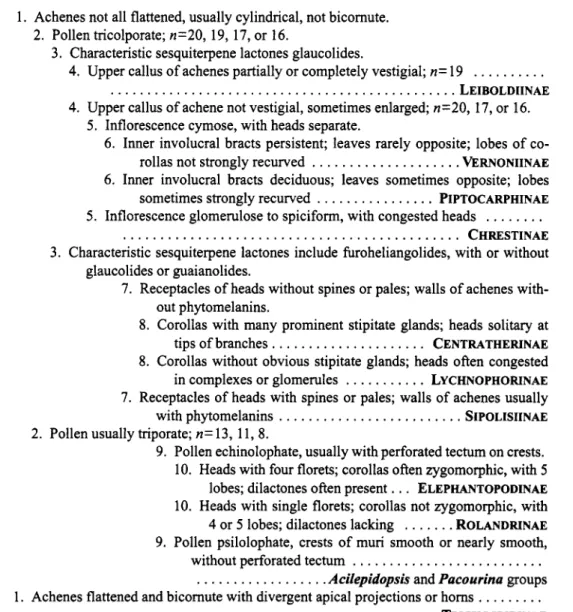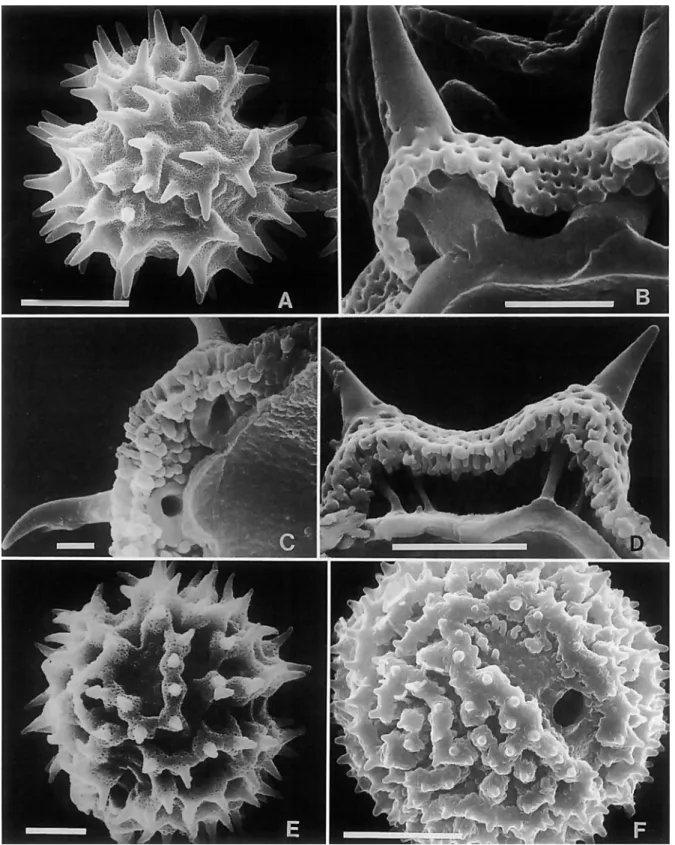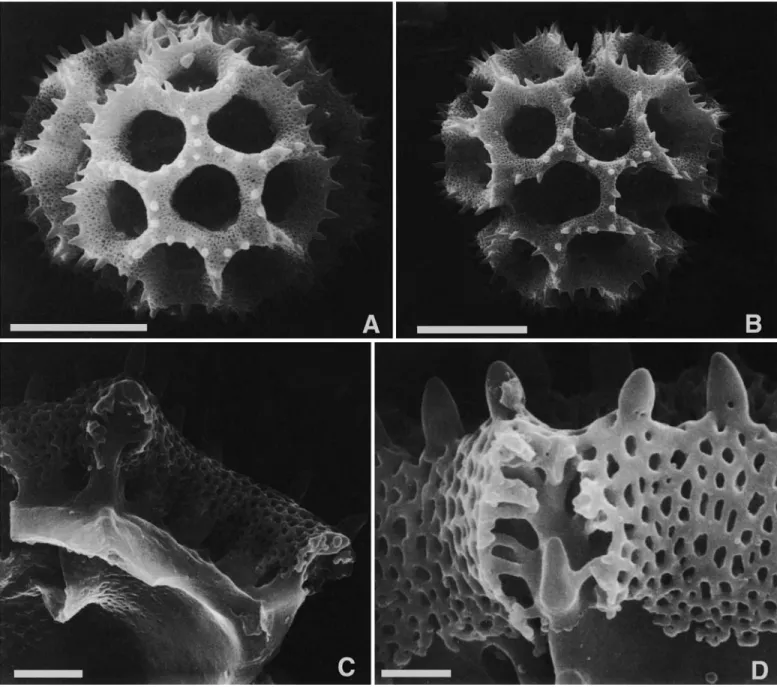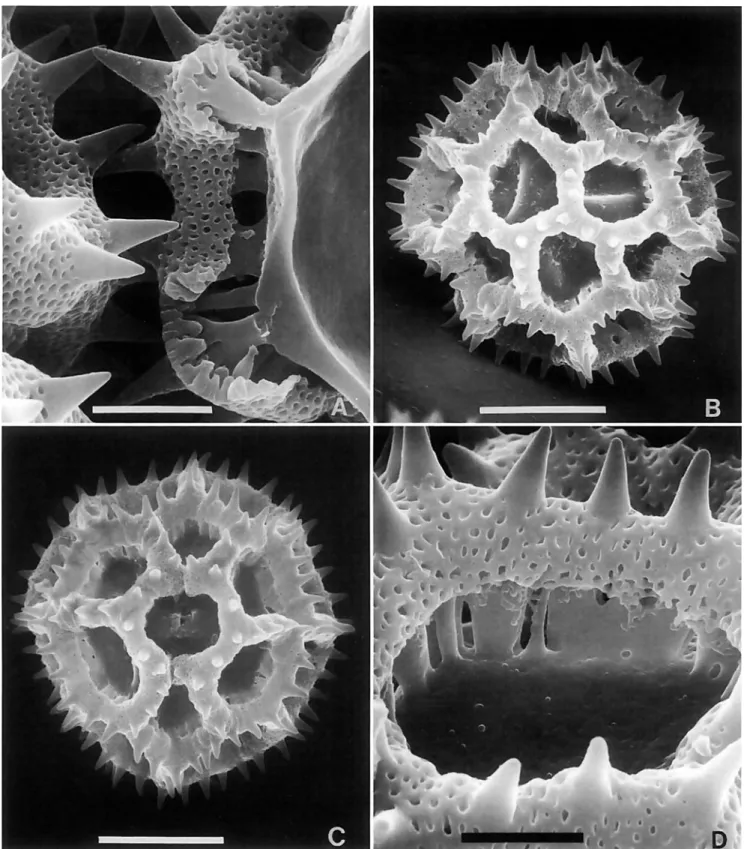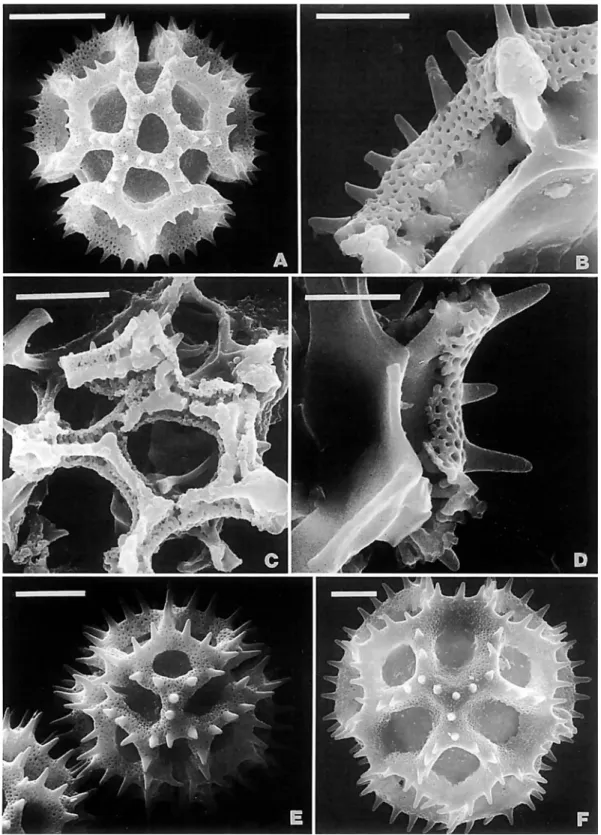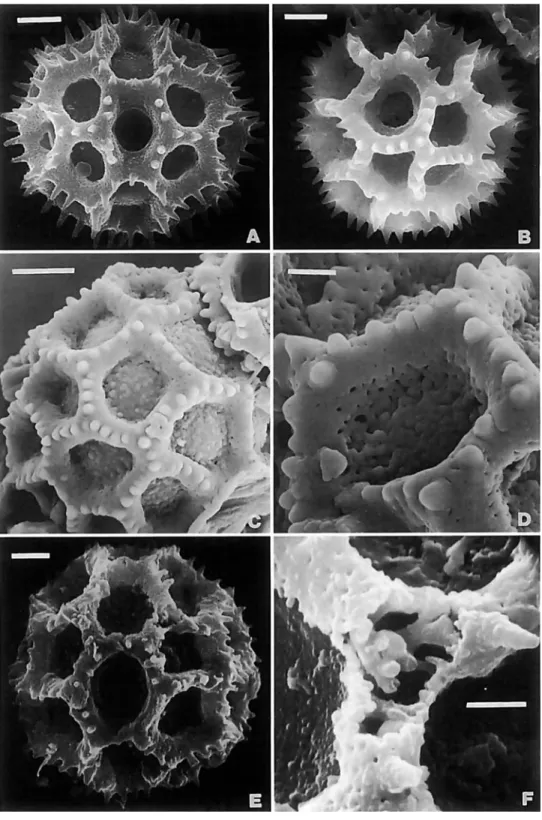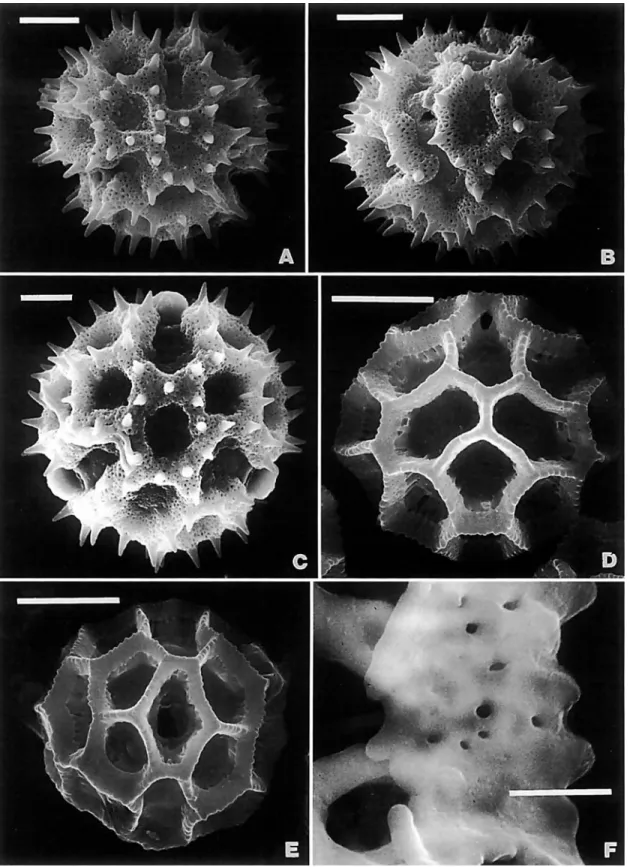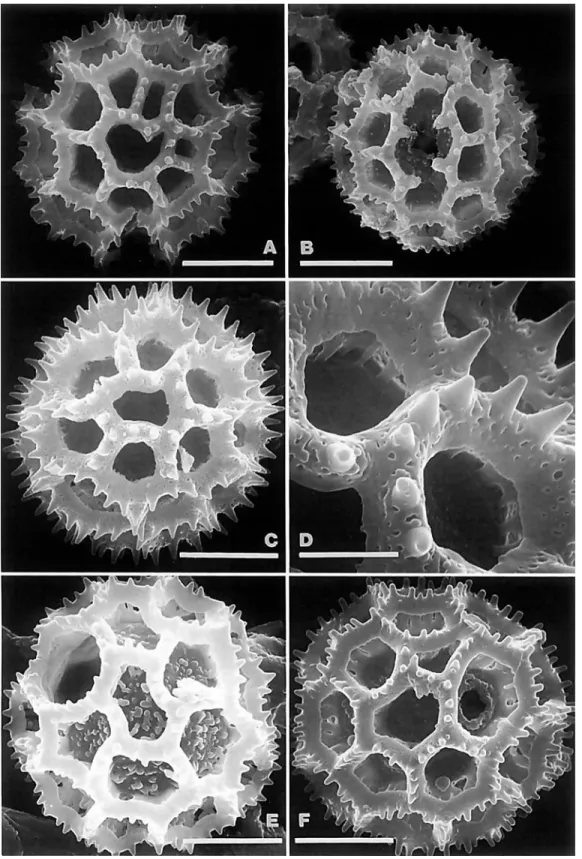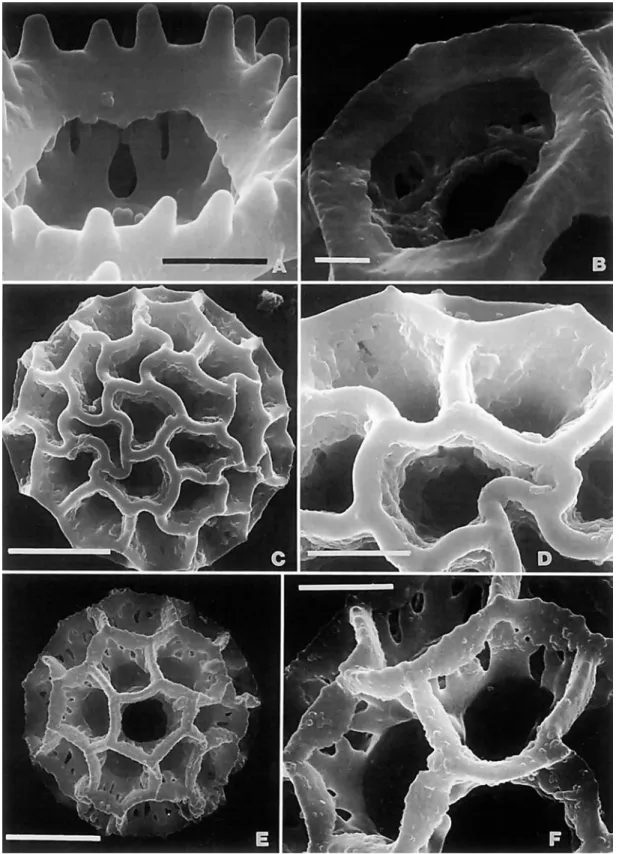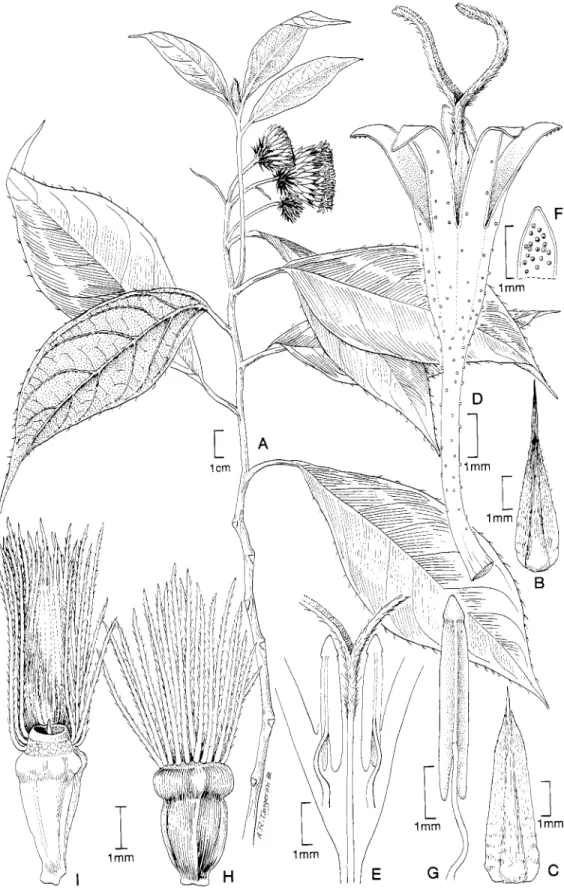S M I T H S O N I A N C O N T R I B U T I O N S T O B O T A N Y N U M B E R 8 9
Generic and Subtribal Classification of American Vernonieae
Harold Robinson
Smithsonian Institution Press Washington, D.C.
1999
A B S T R A C T
Robinson, Harold. Generic and Subtribal Classification of American Vernonieae. Smithso- niun Contributions to Botany, number 89, 116 pages, 1999.-The Vernonieae in America is herein defined to exclude the Liabeae and Pseudostifftiu (Moquinieae), and to include elements sometimes placed in the Heliantheae (Trichospiru) or Lactuceae (Stokesiu). Pollen, style bases, raphids, inflorescence form, involucre, anther appendage, and chemistry are some characters used in the reclassification. Tables 1-12 indicate the distribution of these characteristics in most American genera. Vernoniu s.s., with type A pollen, is typified by K noveborucensis (L.) and occurs in the Bahamas, eastern North America, south to central Mexico and has two spe- cies in temperate South America. All other species previously placed in Vernoniu need to be removed from the genus, a process that is nearly complete for neotropical species. Most Amer- ican Vernonieae seem to form a single related subgroup in the tribe. Subtribes included in the related subgroup are the Lychnophorinae ( x = 15, 17, 18) and Centratherinae (x = 16) with type A pollen and hroheliangolides; Piptocarphinae ( x = 17) with type A pollen, deciduous inner involucre, and sometimes opposite leaves; Vernoniinae (x = 17), many with glanduliferous anther appendages (including the Lepiduplou complex mostly with echinolophate pollen); and the newly proposed subtribes Sipolisiinae with type A pollen, armed receptacles, and carbon- ized achenes; Chrestinae with echinolophate pollen; and Leiboldiinae ( x = 19) with type A pol- len, large heads, and a modified callus at the top of the achene. Of uncertain relationship to the preceding related subgroup are Stokesiu (x = 7), the Elephantopodinae (x = 1 1, 13), and the Rolandrinae ( x = 8) with echinolophate pollen; three genera with type E pollen (Pucourinu, Acilepidopsis, and Mesunthophoru); and the Trichospirinae with type A pollen and flattened bicornute achenes. Ten subtribes are recognized, plus four unplaced generic groups. Three of the subtribal names, Leiboldiinae, Chrestinae, and Sipolisiinae are validated in the treatment.
The genus Cuutingunthus of eastern Brazil, a possible relative of the Elephantopinae, is described as new. A list of the 76 accepted genera of Vernonieae, native or introduced in the New World, is provided, and a complete list of names of American Vernonieae is given with an indication of their present taxonomic dispositions and geographical distributions. Fifteen new combinations are provided.
OFFICIAL PUBLICATION DATE is handstamped in a limited number of initial copies and is recorded in the Institution's annual report, Annuls ofrhe Smithsonian Znstifution. SERIES COVER DESIGN: Leaf clearing from the katsura tree Cercidiphyllum juponicum Siebold and Zuccarini.
Library of Congress Cataloging-in-Publication Data Robinson, Harold Ernest, 1932-
Generic and subtribal classification of American Vernonieae / Harold Robinson.
p. cm. - (Smithsonian contributions to botany ; no. 89) Includes bibliographical references.
1. Vernonia-United States Classification. I. Title. 11. Series.
QKIS2747 no. 89 [QK49S.C74] 580 s a c 2 1 [S83'.99] 99-3 1024
CIP
@ The paper used in this publication meets the minimum requirements of the American National Standard for Permanence of Paper for Printed Library Materials 239.48-1984.
Contents
Page
Introduction
. . .
1Acknowledgments
. . .
3Relationships of the Vernonieae
. . .
3Distinguishing Features of the Vernonieae
...
3Summary of the Subtribes and Genera of the Neotropical Vernonieae
. . .
7Key to the Subtribes and Genera of the Neotropical Vernonieae
. . .
8LEIBOLDIINAE
. . .
8VERNONIINAE
. . .
9PIPTOCARPHINAE
. . .
11CHRESTINAE
. . .
11CENTRATHERINAE
...
12LYCHNOPHORINAE
. . .
12ELEPHANTOPODINAE
. . .
13ROLANDRINAE
. . .
14TTUCHOSPIRINAE
. . .
14American Genera Not Placed in Subtribes
...
14Caatinganthus
...
15Key to the Species of Caatinganthus
...
16Caatinganthus harleyi
. . .
16Caatinganthus rubropappus
...
16Figures
. . .
17Tables
. . .
37Appendix I: NewWorld
. . .
49GenusExcluded
. . .
52Appendix 11: List of Species Names of Western Hemisphere Vernonieae
. . .
53Literaturecited
...
111SIPOLISIINAE
...
13Accepted Generic Names of the Vernonieae Native or Introduced in the
111
...
Generic and Subtribal Classification of American Vernonieae
Harold Robinson
Introduction ment had a brief mention of potentially useful pollen structure The present paper is derived from text and illustrations origi-
nally prepared for presentation at the International Compositae Conference, Royal Botanic Gardens, Kew, in July-August 1994 and for subsequent publication in the Symposium vol- ume. The paper is expanded in the present version to include validation of new subtribes, illustrations of selected genera, scanning electron photomicrographs of pollen (Figures 1-8), il- lustrations of various neotropical Vernonieae (Figures 9-1 8), tables of the subtribes and genera of Vernonieae (Tables 1-12), a description of a new species of Caatinganthus H. Rob. (Fig- ures 19, 20), a list of the Western Hemisphere genera of the Vernonieae with their synonyms, authors, and places of publi- cation (Appendix I), and a complete as possible list of the spe- cies of American Vernonieae with accepted taxonomic disposi- tions and geographic distribution (Appendix 11).
The treatment of the Vernonieae by Bentham in Bentham and Hooker f. (1873) presented a pattern common in traditional concepts of Asteraceous tribes, namely a large core genus, Er- nonia Schreb., and various satellite genera based mostly on variations in pappus and obvious features of the inflorescence.
Some of the primary characters used by Bentham in the treat- ment of the tribe involved congestion of the heads, number of florets in the heads, surface of the receptacle, and presence or absence and texture of tails on the bases of the anther thecae.
The 1873 treatment suffered from the comparatively few char- acters used at the time, the excessively paraphyletic nature of the core genus, Vernonia, the artificial delimitation of many of the segregate genera, and the failure to intercalate the segregate genera into the related parts of the core genus. The 1873 treat-
Harold Robinson, Department of Botany, National Museum Of Natu- ral History, Smithsonian Institution, Washington, D. C. 20560-01 66.
Review Chairman: Warren Wagnel; Department of Botany, Smithso- nian Institution, Washington, D. C. 20560-01 66.
Reviewers: Michael 0. Dillon, Department of Botany, Field Museum of Natural History, Chicago, Illinois, 60605-2496. Guy L. Nesom, University of North Carolina, Chapel Hill, North Carolina, 2 7.599.
that was first used in the taxonomy of the tribe by Steetz (1 864). The Bentham classification was accepted almost with- out change by Hoffmann (1890-1894), differing only in the addition of the genus Gorceixia Baker (1 882) and the transfer of Gongrothamnus Steetz ex Peters from the Senecioneae to the synonymy of Vernonia. This classification, based on Bentham in Bentham and Hooker f. and adopted by Hoffmann, was accepted as traditional by most workers in the tribe for the next ninety years.
The review of the Vernonieae by Jones (1 977) provided the most recent basis for revisional studies in the tribe using pol- len, chromosome numbers, and chemistry. This work was part of a series of studies by Jones and various coauthors (1973- 1986), and various students (Chapman and Jones, 1978; Jones and Faust, 1978; Coile and Jones, 1981, 1983; Keeley and var- ious coauthors, 1978-1980; B.L. King, 1986; Kirkman, 1981;
MacLeish, 1984-1987; MacLeish and Schumacher, 1984; G.L.
Smith, 1981, 1982; and Stutts, 1980, 1981, 1983, 1988). Some of these studies, and work of other recent authors, emphasized trichomes (Faust and Jones, 1973; Pope, 1983), underground systems (Menezes et al., 1979); anatomy (Magalhiies and Alen- castro, 1973; Alencastro, 1978; Carlquist, 1964; Petriella, 1966), pollen (Stix, 1960; C.E. Smith, 1969; Kingham, 1976;
Jones, 1979b, 1981a; Keeley and Jones, 1977b, 1979; Bolick, 1983; Isawumi et al., 1996), presence of latex (Lewinsohn, 199 l), chromosome numbers (Jones, 1974, 1979a; Keeley, 1978; Dematteis, 1996), and nomenclatural details (Nicolson, 1991; Jeffrey and Hind, 1994; Grant, 1994). Jones (1977), Har- borne and Williams (1977), and Robinson, Bohlmann, and King (1980) presented some early apparent correlations of chemical data with classification or geography, and the exten- sive subsequent studies of secondary metabolites were summa- rized by Bohlmann and Jakupovic (1990). Floral dimorphism in the African Vernonia biafrae Oliv. & Hiern was noted by Ay- odele (1 995). Economic value of Stokesia L'Her. was discussed by GUM and White (1974) and in Centrapah galamensis Cass. by Ayorinde et al. (1990), Perdue (1989), and Perdue and various coauthors (1986, 1989, 1993). Also see literature listed
1
2 SMITHSONIAN CONTRIBUTIONS TO BOTANY
on the web site AGRICOLA under the headings Vernonia gala- mensis, K anthelmintica L., and other sources of vernolic acid.
Possible medicinal value of terpenoids in Gymnanthemum umygdalinum (Del.) Sch. Bip. ex Walp. and use by wild Chim- panzees has been reviewed (Huffman, 1991; Jisaka et al.,
1992a, 1992b; Ohigashi et al., 1991).
Most papers about the tribe have emphasized particular geo- graphic areas: United States (Clonts and McDaniel, 1978; Glea- son, 1906, 1922, 1923b; Urbatsch, 1977), Mexico and Central America (Blake, 1926, 1932, 1936; Carvajal, 1981; Elias, 1975;
Jones, 1973, 1976, 1979b; B.L. King and Jones, 1975; Jones and Stutts, 1981; Keeley, 1987; McVaugh, 1984; Robinson and Funk, 1987; Robinson and Reed, 1973; Rzedowski and Calderon, 1995a, 1995b; Tumer, 198 1-1994), West Indies (Adams, 1971; Borhidi, 1992; Ekman, 1914; Keeley, 1978, 1982; Stutts and Muir, 1981; Urbatsch, 1989), Colombia, Vene- zuela, and Guayana (Aristeguieta, 1963; Badillo, 198 1-1989;
Cuatrecasas, 1956; Pruski, 1992, 1996; Robinson, 1992e; Stutts, 1981), Peru (Dillon, 1982, 1984; Jones, 1980), Bolivia (Gleason, 1923a); Brazil (Baker, 1873, 1882; Barroso, 1957, 1959, 1960-1961, 1969, 1970; Cabrera and Vittet, 1961; Cabrera and Klein, 1980; Duarte, 1974; Esteves, 1981, 1992, 1993, 1994;
Hind, 1993, 1994; Jones, 1981b, 1981c, 1982a; Leitao Filho and Semir, 1979; Lobo, 1982; MacLeish, 1984-1 987; Matzenbacher and Mafioleti, 1994a, 1994b; Philipson, 1938b; Schultz-Biponti- nus, 1863; Semir, 1991; G.L. Smith, 1982; Soares Nunes, 1982;
Stutts, 1983, 1988), Paraguay (Cabrera, 1995), Argentina (Cabrera, 1944, 1974, 1978; Ariza-Espinar, 1994), Africa (Bum, 1950; Gilbert, 1986; Gilbert and Jeffrey, 1988; Isawumi, 1984-1995; Isawumi et al., 1996; Jeffrey, 1988; Kalanda, 1981, 1982,1986; Kalanda and Lisowski, 1981; Lisowski, 1987, 1992;
Lebrun, 1985; Philipson, 1938a; Pope, 1986a, 1986b, 1992; C.E.
Smith, 1971; Steetz, 1864; Wild, 1977, 1978; Wild and Pope, 1977-1978), Madagascar (Humbert, 1960), Thailand (Koyama, 1984), Malay or Indo-Malesia (Koster, 1935).
Some studies during the last 30 years have dealt with the lim- its of the Vernonieae. It was recognized that Llerasia Triana was not a synonym of Vernonia but was an older name for an Andean genus of the tribe Astereae (Cuatrecasas, 1970). Con- fusion between the Vernonieae and Eupatorieae was dealt with by Robinson (1977a, 1977b). Liabum Adans. and its relatives were once treated as members of the Vernonieae (Cassini, 1823, 1825, 1830), then long treated as part of the Senecioneae (Bentham in Bentham and Hooker f., 1873; Hoffmann, 1890-1 894). They were returned to the Vemonieae (Nash, 1976) but are now generally accepted as members of the dis- tinct tribe Liabeae (Rydberg, 1927; Robinson and Brettell, 1973b, 1974; Robinson, 1983d; Bremer, 1994). The description in the Vernonieae of Pseudostifltia (Robinson, 1979d) from Brazil was followed by the addition of the related Moquinia DC. (Gamerro, 1990) and then by the transfer of both genera to the new tribe Moquinieae by Robinson (1994a). The South Af- rican Hoplophyllum DC., traditionally placed in the Vemon- ieae, was shown by Karis (1992) to be related to Eremotham-
nus Hoffm. Eremothamnus and Hoplophyllum were placed by Robinson (1992c, 1994a) in the tribe Eremothamneae, which is most closely related to the Arctoteae. Corymbium L. of South Africa (Weitz, 1989) is now also regarded as not a member of the Vemonieae, especially on the basis of chemistry (Bohlmann and Jakupovic, 1990), but it remains unplaced tribally. Some elements added to the tribe or confirmed as members of the tribe are Stokesia L'Her. and Trichospira H.B.K. Stokesia was sometimes compared with the Lactuceae because of the ligu- late form of most of the florets in its heads (Cronquist, 1955), but it has usually been properly placed in the Vernonieae (Bentham and Hooker f., 1873; Hoffmann, 1890-1894; Jones, 1977). Trichospira was placed in the Vernonieae by Cassini (1819) but was placed in the Heliantheae in traditional treat- ments of the Asteraceae (Bentham and Hooker f., 1873; Hoff- mann, 1890-1894). It was transferred to the Vernonieae by Robinson and Brettell(1973a) and was included in that tribe by Dillon (1 982), a disposition supported in general in the pollen study by Bolick (1983). The most interesting additions to the tribe were the various synonyms of Distephanus Cass. (Gon- grothamnus Steetz, Newtonia Hoffm., and Antunesia H o f i . ) that were rather consistently placed in the Senecioneae in the traditional systems of classification (Bentham and Hooker f., 1873; H o h a n n , 1890-1894, 1893) because of their yellow florets and trinervate leaves. The placement in the Vernonieae is discussed fully by Robinson and Kahn (1986). A recent DNA study suggests that the Hawaiian Hesperomannia is a member of the tribe (Kim et al., 1998).
A DNA study of the tribe (Keeley, 1994) has produced a pre- liminary strict consensus tree of various New and Old World species of krnonia s.1. The study stated that the hypothesized division between Old and New World Vernonieae (Jones, 1977, 1979a, 1979b, 1981a; Robinson et al., 1980; Jeffrey, 1988) is not supported by the cpDNA data. The cpDNA study claimed to support the suggestions by the same previously cited authors (Jones, 1977, 1979a, 1981; Robinson et al., 1980; Robinson and Funk, 1987; Jeffrey, 1988) that Vernonia s.1. is paraphyletic or possibly polyphyletic. Some seeming violations of the hemi- spheric monophyly in the authors' published tree are not sup- ported by fully resolved phyletic results. The strikingly anoma- lous elements in the study are the Old World and widely adventive Cyanthilliurn patulum (Aitch.) H. Rob. (as krnonia chinensis) positioned among species of the New World Ver- nonia S.S. and krnonanthura H. Rob., and members of the New World Lepidonia-Stramentopappus group in a position between various African groups. Keeley and Jansen (1994) concluded that the subdivision of krnonia s.1. into segregate genera is premature.
The publications of Robinson and various coauthors (1973-1999) about the Vernonieae initially included only descriptions of new species, but the aim has increasingly been to produce a full generic revision of the tribe with description of new genera and restoration of some older genera that had been placed in synonymy. As mentioned in the study of Di-
NUMBER 89 3 stephanus (Robinson and Kahn, 1986), the subdivision of Ver-
noniu was considered inevitable as early as the initial study of subtribes by Robinson, Bohlmann, and King (1980). An attempt at a complete generic revision of the neotropical mem- bers of the tribe is presented herein. Partial results of the series of studies were included in the review by Bremer (1 994). The 76 genera presently recognized in the Americas are listed with synonyms in Appendix I.
During the segregation of various neotropical genera from Ver- noniu, the overall pattern of relationships has become clearer, but some of the characters used in earlier papers of the series to dis- tinguish subtribes and genera have needed refinement. Examples can been noted below in the review of subtribes under the rela- tionships and generic limits of Lessingiunthus H. Rob. and under the delimitation of the Piptocarphinae.
In other cases, during the present series of studies, generic distinctions have followed already known alignments of char- acters. The limits of the genus Vernoniu s.~., which have finally been recognized, were precisely anticipated by Gleason in his key subgrouping and treatment of species 89-123 in the treat- ment of Vernoniu s.1. in the North American Flora (1922).
ACKNOWLEDGMENTS.-Many people, particularly those cit- ed in the literature, are thanked for their contributions to the present understanding of the Vernonieae. Among these I espe- cially thank the late Jose Cuatrecasas. John Pruski of the De- partment of Botany, National Museum of Natural History (NMNH), is thanked for many suggestions. The drawings were prepared by Alice Tangerini of the Department of Botany. Pol- len photos were taken in the NMNH Scanning Electron Micro- scope (SEM) lab, supervised by Walter Brown and aided by Suzanne Braden and Brian Kahn. Pollen material was prepared in the laboratory of Joan Nowicke by Brian Kahn, Mary San- grey, Barbara Eastwood, and Margie Knowles. Photographs were printed by Margie Knowles, Stanley Yankowski, and members of the NMNH photo services unit.
Relationships of the Vernonieae
The tribe is considered closest to the tribes Lactuceae and Liabeae (Robinson, 1983d), but some variations in this rela- tionship have been proposed recently using cpDNA and cladis- tics (Jansen et al., 1988, 1991; Bremer et al., 1992). The Ver- nonieae is believed to have originated in the Eastern Hemisphere (Bremer, 1994) where the most divergent element of the tribe, the yellow-flowered and trinervate-leaved Dis- tephunus occurs. The Eastern Hemisphere is also where almost all the Vernonieae with x = 9 or 10 occur. The higher chromo- some numbers found in the Western Hemisphere Vernonieae follow the pattern of higher numbers in members of groups invading new geographical areas. This is the view accepted herein for all Vernonieae except perhaps Trichospiru.
If it is true that the Vernonieae arose in Africa or Asia, they were orginally geographically closer to the Lactuceae and re- mote from the strictly neotropical Liabeae. It is the Lactuceae
that often show a style form more closely similar to that of the Vernonieae, and it is the Lactuceae that show a similar pattern of lophate pollen, apparently reverting commonly to type A pollen. As noted by Lewinsohn (1991), the Vernonieae some- times even have latex like the Lactuceae and most Liabeae.
Even though most Western Hemisphere Vernonieae are un- doubtedly derived from Eastern Hemisphere ancestors, one Western Hemisphere genus, Trichospiru, may be a relict of an even more remote ancestry. The flattened, bicornute, echinate achenes of the latter genus are unlike anything else seen in the Vernonieae, Liabeae, or Lactuceae. If there is an older Ameri- can ancestral element of the Vernonieae, the origin and rela- tionship of the tribe could be closer to the Western Hemisphere Liabeae. The majority of American Vernonieae would still be interpreted as introductions or reintroductions from the Eastern Hemisphere.
Distinguishing Features of the Vernonieae
Perennial or rarely annual herbs to shrubs, small trees, or vines, with decumbent to xylopodial bases, rarely with latex.
Hairs simple, monoseriate, T-shaped, stellate, or glandular.
Leaves usually alternate, more rarely opposite or ternate, some- times in basal rosette, sessile or petiolate. Leaf blades usually pinnately veined, rarely trinervate, margins entire to lobed or spiny, often with glandular dots. Inflorescence cymose or with cymose branches, often scorpioid or seriate cymose, more rarely glomerulate or syncephalous and simultaneously flower- ing or spiciform. Heads discoid, sometimes with outer rows flowering on one day and remaining florets flowering on fol- lowing day, homogamous, 1-200-flowered, florets usually bisexual and fertile; involucral bracts few to many, in 1 to about 12 series, usually closely imbricated, sometimes with expanded foliose or colored tips, inner bracts persistent or deciduous; receptacle flat to convex, glabrous, or with awns, pales, or partitions, rarely with achenes completely immersed.
Corollas reddish to purplish or white, rarely yellowish, tubular or rarely ligulate to bilabiate, tube short to elongate, lobes 3,4, or 5 , usually longer than throat, rarely divided to base of limb, usually narrowly oblong to linear, glabrous to villous outside, limb rarely pubescent inside; anther bases usually calcarate, with or without sterile appendages, endothecial cells subquad- rate, with polarized thickenings, apical appendage not con- stricted at base, with or without glands; style base immersed in nectary, with or without basal enlargement or differentiated basal ring; style branches spreading laterally, slender, acute, with continuous stigmatic surfaces inside extending almost to tip, with outer surface and upper style shaft bearing long sweeping hairs. Achene terete to triangular or obcompressed, usually 1 0-ribbed, sometimes 3-5-angled, rarely dimorphic, densely setuliferous or glanduliferous to glabrous, often with idioblasts, rarely slightly winged, usually with raphids, very rarely carbonized; pappus usually with capillary bristles, usu- ally with outer series of squamellae, sometimes totally squami-
4 SMITHSONIAN CONTRIBUTIONS TO BOTANY form or coroniform, persistent to deciduous. Pollen 37-80 pm
in diameter (in fluid) tricolporate to triporate, echinate and sublophate, or echinolophate to lophate without spines or per- forated tectum. Characteristic secondary metabolites being highly oxygenated germacranolides and simple acetylenes (polyines). Diterpenes, phenyl propanes, and p-hydroxyace- tophenone derivatives absent.
Members of the Vernonieae can be distinguished from most Eupatorieae in the field by the lateral rather than radial spreading of the style branches (Robinson, 1984). Most Vernonieae have alternate leaves and long corolla lobes, whereas most Eupato- rieae have opposite leaves and corolla lobes rarely much longer than wide. Many traditional characters, chromosome number data of Jones (1974, 1979a) and Keeley (1978), and much of the secondary metabolite data summarized by Bohlmann and Jak- upovic (1990) are used in the present classification. The structur- al characters include the base of the plant, phyllotaxy, leaf vena- tion, hair types, shape of the inflorescence, persistence of the inner involucral bracts, surface of the receptacle, number of involucral bracts and florets, color and shape of the corolla, pubescence of the corolla, length of corolla lobes, form of anther bases, anther appendages, basal node of the style, sweeping hairs on the outside of the style branches and upper style shaft, shape and dimorphism of achene, achene wall structure, raphids, upper callus of the achene, pappus structure, and form of pollen. These characters require the following brief comments.
BASE OF PLANT.-The present study is mostly based on her- barium material, and the bases have not been consistently available for study. Nevertheless, the stem bases in Vernonia
S.S. and Acilepidopsis H. Rob. seem distinctive in their rather decumbent nature. They completely lack the xylopodia that are common in many other members of the tribe, especially many savanna species of Vernonanthura.
PHYLL0TAXY.-Members of the Vernonieae are almost all alternate leaved. As one exception in Africa, some species of Bothriocline Oliver ex Benth. have opposite or ternate leaves.
In the Neotropics, most species with opposite leaves belong to the Piptocarphinae, Critoniopsis Sch. Bip., Joseanthus H. Rob., or Piptocarpha R. Br. Opposite leaves occur in one localized Colombian forma of Lepidaploa canescens (Robinson, 198 1 b), and Lepidaploa verticillatu Proctor ex Adams, of Jamaica has ternate, opposite, and alternate leaves.
LEAF VkNATION.-Most members of the tribe have pinnately veined leaves. The most important exception is Distephanus of the Eastern Hemisphere, a genus increasingly regarded as a pleisiomorphic element in the tribe (Bremer, 1994). Keeley and Turner (1990) note the trinervate foliose bracts in the inflores- cence of the Brazilian Hololepis DC.
HAIR TYPES.-Trichomes in the tribe have been studied repeatedly (Faust and Jones, 1973; Pope, 1983; Isawumi, 1984, 1989), and Jeffrey (1988) used the presence or absence of T-shaped hairs as a key character distinguishing major groups of Vernonia in Africa. Stellate hairs are found in such neotropi- cal genera as Ekmania Gleason, Piptocarpha, and Critoniopsis
of the Piptocarphinae. The present series of studies includes description of some extreme serial T-shaped hairs in Quechua- lia H. Rob., but it has been more concerned with various types of hairs occurring inside of corollas (Figures 1 3 ~ , ~ ; 14E,G) (Robinson, 1993b).
SHAPE OF THE INFLORESCENCE.-The tribe is notable for one of the most striking exceptions to cymose inflorescences in the Asteraceae in the genus Pithecoseris Mart. (Figure 1 6 ~ ) . The cymose condition in most of the tribe attains an extreme condition that has been referred to as scorpioid cymose (Figure 12A), but a term, seriate cymose, has been introduced in the present series of studies for the majority of the so-called scorpi- oid cymes in the tribe that are not scorpioid (Robinson, 1987c, 1988b, 1990b; Figure 1 1 ~ ) . The latter forms of inflorescence seem to be almost restricted to neotropical members of the tribe. An instance of apparent developmental conversion of a seriate cyme to a spiciform cyme has been seen in Lessingiant- hus (Robinson, 1988b). The cymose form of the whole inflo- rescence in Vernonia S.S. versus the restriction of the strongly cymose form to branches, as in Vernonanthuru (Robinson, 1992b), was anticipated in the key to Vernonia s.1. by Gleason (1922).
PERSISTENCE OF INNER INVOLUCRAL BRACTS.-In the neo- tropical Vernonieae, the Piptocarphinae mostly show obviously deciduous inner involucral bracts. Other subtribes, such as the Vernoniinae, usually show involucral bracts widely spreading and persistent with age.
SURFACE OF THE RECEPTACLE.-Most members of the Ver- noniinae have an unornamented receptacle surface that is con- sidered pleisiomorphic. The occurrence of pales is somewhat erratic; it occurs in Bolanosa A. Gray of Mexico, one Guatema- lan species of Lepidonia S.F. Blake, and a group of genera in Brazil herein placed in the new subtribe Sipolisiinae. The latter group has both pales and long bristles that seem to be develop- mentally equivalent in spite of their different structure.
Blanchetia DC. has thin partitions enclosing the bases of its achenes, whereas Albertinia Spreng. has deep holes in the receptacular surface that enclose the full lengths of the achenes.
It is questionable whether the structures in Trichospira are pales or whether the structures are remnant involucral bracts in reduced compound heads.
NUMBER OF BRACTS AND FLORETS.-The number of florets in the heads varies from one to many hundred. The ratio of involucral bracts to florets also may vary in significant ways, such as nearly 1 to 1 in typical Vernonia and in Lepidoniu, but 2 to 1 in many members of the Lepidaploa complex. Marked reductions in flower number, as in Vernonia angustifolia Michx., K fasciculata Michx., and Chrysolaena H. Rob., and marked increases in involucral bracts, as in Echinocoryne H.
Rob., may drastically alter the ratio.
the tribe have purplish to white corollas. The occurrence of yel- low corollas is apparently restricted to the Eastern Hemisphere genus Distephanus, which is also notable for its distinctive leaf COLOR AND SHAPE OF THE COROLLA.-Most members of
NUMBER 89
venation. Varying degrees of zygomorphy are found in scat- tered nearctic and neotropical members of the tribe, Stokesia, Dipterocypsela S.F. Blake, Mattjkldanthus H. Rob. and R.M.
King, and the Elephantopinae.
PUBESCENCE OF THE COROLLA.-The pubescence varies from glabrous or with hairs simple, multicellular, and T-shaped to stellate. One useful character in the present study has been the various types of hairs inside the corolla in Dasyandantha H.
Rob., Dasyanthina H. Rob. (Figure 13D,E,I), and Quechualia (Figure 14~,G, Robinson, 1993b).
The glabrous corollas in the typical Vernoniinae contrast with the pubescent corollas in most members of the Lepidaploa complex of the same subtribe.
COROLLA LOBES.-The corolla lobes of the Vernonieae are erect when mature or sometimes distorted, especially in mem- bers of the Piptocarphinae, but they are rarely rolled strongly backward as in most Mutisieae. The lobes are usually longer than the throat but are unusually short in a few neotropical examples. The lobes are separated to the base of the limb in Joseanthus (Figure 1 5 ~ ) and Cuatrecasanthus H. Rob., and they are shorter than the throat in Cololobus H. Rob. (Figure 1 0 ~ ) . The only other such short lobes on a disciform corolla in the tribe are, as illustrated, in a paleotropical species from Socotra, described by Jeffrey (1 97 1). The veins of the lobe are distally strongly thickened in many members of the tribe and may form a thickened shield in such genera as Matgeldanthus.
Other genera, such as Chrysolaena, have characteristically thinner veins. The interior of the lobe is filled with sometimes obvious longitudinal ducts in krnonanthura and Trepadonia (Robinson, 1994c).
ANTHER BASES.-The bases of the anthers in the tribe are usually calcarate or spurred, with the pollen-bearing anther the- cae extending below the point of attachment to the filament. The actual point of attachment may be obscure because of the way the anther collar lies between the spurs. This spurred condition is found in most members of the subfamily Cichorioideae, but in the Elephantopinae and in Xiphochaeta Poeppig. the bases are shorter than the anther collars. Traditionally, Piptocarpha has been distinguished in the tribe by having tails, or sterile exten- tions on the basal ends of the thecae, but the true distinction seems to be the sclerified and often sharply pointed nature of those tails. Tails as long or longer occur in many other genera of the tribe, such as Distephanus (Robinson and Kahn, 1986), k r - nonanthura (Robinson, 1992b), and Critoniopsis (Robinson, 1993a). The distinctive Acilepidopsis actually has anther tails as sharp and sclerified as those of Piptocarpha, and blunt sclerified tails are seen in Hololepis.
APICAL ANTHER APPENDAGES.-The apical appendages of the anther vary from thin-walled to very thick-walled. The lat- ter condition is rather characteristic of the Piptocarphinae and Lychnophorinae, and occurs in such unplaced genera as Acil- epidopsis and Pacourina Aubl. Only the appendages with thin-walled cells, such as those of the Vernoniinae, bear glands.
One gland seen on the anther of a Piptocarpha trifora (Aubl.)
5 Benn. ex Baker seemed anomalous in that genus, and it was placed oddly on the edge of the theca.
BASAL NODE OF THE STYLE.-The character has been used extensively in the Vernonieae of both Hemispheres. Distepha- nus is distinct in having a greatly enlarged node (Robinson and Kahn, 1986), whereas Isawumi (1 993) noted the complete lack of a node in Baccharoides Moench correlated with a high, sheathing nectary. In the Neotropics, a basal stylar node seems characteristically lacking in the Lychnophorinae and Centrath- erinae among others. The node is usually present in the Pipto- carphinae but is lacking in the generic group of Piptocoma Cass. (including Pollalesta H.B.K.) and Ekmania. A node is usually present in the Vernoniinae, but there have been separate reductions in such genera as Chrysolaena (Robinson, 1988c) and Lessingianthus (Robinson, 1988b), where there is at least one exception (in L. regis).
achenes are strongly obcompressed in Dipterocypsela and Het- erocypsela H. Rob., and lateral margins of the former appear winged. The achenes of Pithecoseris and the type species of Lychnophoriopsis Sch. Bip. are described as biformed (Baker, 1873), the inner differing in shape, pubescence, fertility, or shape and persistence of the pappus. The heteromorphism of the achenes, like that described from Lychnophoriopsis hete- rotheca Sch. Bip. has not been seen in any other members of the genus (Robinson, 1992d).
ACHENE WALL.-The most interesting character seen in the tribe is carbonization of the inner wall of the achene in four gen- era herein placed in the Sipolisiinae. The character was once thought to be restricted to the Eupatorieae and Heliantheae. Such carbonization also occurs in the Blepharispermum group that has been erroneously placed in the Heliantheae on the basis of the character (Eriksson, 1991).
The presence or absence of setulae (twin-hairs) or glands (short-stalked capitate glands) is a character of some genera.
Glands have not been seen in Lessingianthus, although they are common in the related Lepidaploa. Hind (1993) stated that glands were present in L. myrsinites H. Rob., but reexamina- tion of material indicates that the structure Hind saw must be what are referred to herein as idioblasts or resin cells. The latter are differentiated cells in the outer surface of the achene and are not the trichomes called glands herein.
RAPH1DS.-The shape of the raphids in the wall of the achene is theoretically an excellent character in neotropical Vernonieae, but the crystals are often hard to see. The shape also can be mistaken if quadrate forms are viewed from the side or if the seam between two joined subquadrate cystals is not noticed. The raphids are short in typical Vemoninae, such as Vernonia and Cololobus (Figure 1 0 ~ ) . The shape varies in a few genera, such as Chresta Vell. ex DC., of the Chrestinae, but in the Lepidaploa complex of the Vemoniinae, elongate raphids correlate closely with rhizomatous crests on the lophate pollen and distinguish Lepidaploa and its most closely related genera from Aynia H. Rob., Pseudopiptocarpha H. Rob., Harleya S.F.
SHAPE AND DIMORPHISM OF THE ACHENE.-The peripheral
6 SMITHSONIAN CONTRIBUTIONS TO BOTANY Blake, and most Lessingianthus. Some genera, such as Steno-
cephalum Sch. Bip., seem to characteristically lack raphids, and raphids appear to be lacking in members of the Sipolisia group that have carbonized achene walls. Elongate raphids oc- cur in a few other neotropical groups not directly related to the Lepidaploa complex, such as Dasyandantha, Dasyanthina (Figure 1 3 ~ ) , and Quechualia (Figure 1 4 ~ ) of the Vernoniinae and Chresta.
The Lepidonia group of the Vernoniinae is notable for a pro- gressive reduction of the upper achene callus (Figure 91) (Rob- inson and Funk, 1987). The reduction series can be interpreted as loss of an outer layer bearing the pappus followed by loss of an inner ring. An expanded callus appears to be responsible for the pappus collar seen in Struchium P. Brown. A capillary pap- pus with an outer series of short bristles or squamellae is con- sidered pleisiomorphic in the tribe. A recurring variation has an outer series that grades into the inner series without clear dis- tinction. The bristles can be short in Lepidonia and Lessingian- thus, but genera have not been based on that character alone in either the traditional or present classifications. Vernonieae with a pappus flattened (Stilpnopappus Mart. ex DC., Xiphochaeta), twisted (Lychnophora Mart.), with reduced number of seg- ments (Ehania, Piptocoma Cass., Elephantopus L.), or with only fused outer sheath or collar (Gorceixia Baker, Huberopap- pus Pruski, Struchium) have traditionally been distinguished at the generic level.
POLLEN.-The pollen in the Vernonieae is one of the most useful characters available, and it is inexplicable that taxa would be described at this time without detailed description of the pollen. It seems no accident that the use of pollen in the tax- onomy of the tribe goes back to the work of Steetz in 1864.
Some pollen variation in the tribe was reviewed by Stix (1960), but the pollen types cited herein follow mostly Keeley and Jones (1977b, 1979) and Jones (1979c, 1981a). The majority of the important pollen characters can be observed with any com- pound light microscope. Only the rhizomate versus baculate form of the lophate crests requires SEM for confirmation. A recent integration of pollen into a generic survey is in the review of the tribe in the Guianas (Robinson, 1992e). Tricolpo- rate echinolophate variants are discussed in the treatment of Lepidaploa (Robinson, 1990b).
Fractured pollen grains revealed a significant character of the Vernonieae that differs from the related Liabeae. In the Vernon- ieae, the spines of echinate grains have a single solid columella or baculum centered under each spine (Figure 1B). In the Lia- beae, the columellae under the spines are either hollow or form a cluster around an open center (Figure IC,D). As illustrated in TEM sections by Skvarla et al. (1977), the Lactuceae also have open centers under the spines.
The present series of studies of the Vernonieae have shown a number of isolated examples of lophate pollen apparently reverting to type A pollen within genera or within well-defined generic groups (Cyrtocymura H. Rob., Eirmocephala H. Rob., UPPER CALLUS OF THE ACHENE AND PAPPUS STRUCTUFE-
Lessingianthus, Lepidaploa). These examples and the overall pattern of distribution of pollen types in the tribe indicate that the lophate forms are pleisiomorphic. The comparatively com- plex lophate pollen forms occur throughout the diversity of the tribe, in both Hemispheres, and it is considered impossible that they have independently and repeatedly re-evolved from the comparatively simple type A pollen. It is personally believed from these studies that the lophate forms of pollen in the Ver- nonieae and the related Lactuceae have a common origin, and that the type A pollen in both tribes is probably derived repeat- edly by some sort of reversion. The Lactuceae have a similar mixture of pollen types that have been difficult to interpret sys- tematically (Tomb, 1977).
Although the type A pollen is apparently a reversion from lophate forms, it has become fixed in some groups of the neo- tropical Vernonieae, such as the Lychnophorinae, Piptocarphi- nae, and the Vernonia- Vernonanthura element of the Vernonii- nae. The result of the common reversion of lophate pollen to type A is that the co-occurrence of such pollen in different groups of the Vernonieae may have little phyletic significance.
The co-occurrences of any of the basically different forms of lophate grains seem to be far more phyletically significant.
There is no evidence in the neotropical Vernonieae of type A pollen reverting to lophate forms, but the pollen variation in Old World Distephanus involves a lophate form that differs from type A only in the continuity of different parts of the exine (Robinson and Kahn, 1986), and changes seem likely in both directions in that genus.
The type A pollen shows some variation in size, usually being about 40 pm in diameter, as measured in fluid or Hoyer's solution, but being 50-60 pm in diameter in Lepidonia (Robin- son and Funk, 1987) and Lessingianthus cephalotes (DC.) H.
Rob. and about 45 pm in diameter in L. glaziovianus (Baker) H. Rob. (Robinson, 1988b). The type A pollen grains may show apical patterns of spines similar to the lophate patterns in type C and type G grains (Robinson, 1987~). In fact, careful examination of the whole surface of the grain shows a pat- terned distribution of spines that is referred to herein as sublo- phate. A few taxa, such as Bishopalea H. Rob. (Figure l ~ ) , have spines strongly oriented in muri, but the perforated tectum is continuous between the muri as in other type A grains. The unique pollen of Orthopappus Gleason looks like an unusual type A under the light microscope, and it is best classified in that category, but the surface actually consists of dense irregu- lar muri with narrow gaps between (Figure 1F). These type A grains all differ from the pattern with evenly distributed spines of truly echinate grains seen in other tribes.
The echinolophate pollen types of most neotropical Vernon- ieae are tricolporate with orderly patterns of lacunae or areoles at the poles. The perforated tectum is restricted to the muri, often not in contact with the footlayer at the sides of the muri.
The colpi are the primary organizational feature of the grains.
Type C grains have single polar lacunae (Figure 4A), whereas types B (Figure 2B), D (Figure 4F), G (Figure 4E), and the
NUMBER 89 7 Aynia type (Figure 3B) lack them. Of the last four types, the
lacunae converging on the poles in the first three are aligned with the colpus, whereas the lacunae at the poles in the Aynia-type are aligned with the intercolpus. The crests of these echinolophate grains retain a perforated tectum. The attach- ment of the crests to the footlayer is by stout baculae in genera such as Lessingianthus (Figures 2C, 3A), Aynia (Figure 3D), and Pseudopiptocarpha, but the baculae form a horizontal rhi- zome that is weakly attached to the footlayer in other members of the Lepidaploa complex (Figure 4B,D). The rhizomate char- acter cannot be seen with the compound microscope, but its presence is sometimes evident by the ease with which the crests are stripped ftom the grains in pollens of that type (Fig- ure 4c).
There are a few lophate pollen types, such as those in the Vernoniine genera Struchium (Figure 5C,D) and Heterocypsela (Figure 5E,F), which have both polar lacunae and crosswalls in the colpi above and below the pores. The columellae of the muri are short and irregular (Figure 5F). These pollens occur in groups characterized by tricolporate grains, and the grains dif- fer from triporate types cited below by their simple polar lacu- nae.
Additional types of pollen in the Vernonieae are triporate.
These triporate pollen types can be differentiated by the indefi- nite patterns formed by the two or more series of lacunae sur- rounding the poles. The colpi are usually obscured or lacking, and the pores are located in lacunae scarcely differing in form from the lacunae that do not contain pores. The triporate grains of this type are most common in Vernonieae native to the East- ern Hemisphere, such as the widely adventive Cyanthillium Blume. Two groups with echinolophate triporate pollen are the pantropical Elephantopiinae (Figure 7A-E) and the neotropical Rolandrinae (Figures 7F, 8A,B). Genera with triporate pollen that do not have spinules or a perforated tectum are Pacourina (Figure 8C,D), Acilepidopsis, and Mesanthophora H. Rob. (Fig- ure 8E,F). The Pacourina type nonechinate triporate pollen was cited by Jones (1 98 la) as type E, and it was cited from only pa- leotropical members of Vernonia s.1. The three neotropical gen- era with type E pollen all seem to have only remote relation- ship to other neotropical Vernonieae.
SECONDARY METABOLITES.-Differences in sesquiterpene lactones and flavonoids between American and paleotropical species were mentioned by Jones (1977) and Harborne and Williams (1977). The flavonoids of American species are more complex, consisting of both flavones and flavonols.
The summary by Bohlmann and Jakupovic (1990) cited oth- er more recent literature on the subject. Their summary also mentioned primarily terpenoid secondary metabolites of sys- tematic interest. The 5-alkylcoumarins seemed restricted to the distinctive paleotropical group, including Cyanthillium, Ethu- lia L.f., Bothriocline (including some reported as Erlangea Sch. Bip.), and Volkensia 0. Hoffm. A distinctive neotropical genus with possible paleotropical relationships, Acilepidopsis, lacks the specialized sesquiterpene lactones seen in other neo-
tropical groups, and it is the only member of the tribe known with phenylpropanes (lignanes). Furoheliangolides show a sig- nificant distribution in subtribes recognized herein as Lychno- phorinae, Centratherinae, and Sipolisiinae, but they are lacking in the Vernoniinae and Piptocarphinae. The Vernoniinae, Pipto- carphinae, and Rolandrinae, in contrast, are noted for the pres- ence of glaucolides and related sesquiterpene lactones. Bohl- mann and Jakupovic (1 990) concluded that Chresta should be rejected from its traditional position in the Lychnophorinae because of the presence of glaucolides, a rejection that is re- enforced in this study by examination of pollen and anther appendages.
CHROMOSOME NUMBER-The principal sources of chromo- some numbers continue to be Jones (1974, 1979a) and Keeley (1978), but some more recent counts were cited by Keeley and Turner (1990). Some new reports with karyological details and a review of other sources were provided by Ruas et al. (1991).
Papers cited by Ruas et al. included Cabrera (1944), Coleman (1968), Hunter (1964), Jones (1968, 1970, 1974, 1977, 1982b), Jones and Duncan (1966), Keeley (1978), Keeley and Jones (1977a), Powell et al. (1974), Sundberg et al. (1986), and Turner (1981). A basic pattern of x = 9 or 10 for paleotropical Vernon- ieae and x=16 or 17 for American Vernonieae was first men- tioned by Jones (1977). Stokesia has been the most notable exception, but a few other apparent exceptions were mentioned by Keeley and Turner (1990). The LeiboldidLepidonia group seems distinct in its count of n=19. Ruas et al. (1991) empha- sized the different numbers reported for many species, especially the n=17 ( 2 ~ 3 4 ) and n=20 ( 2 ~ 4 0 ) that have been reported from two members of Chrysolaena (C. flexuosa Sims and C.
platensis (Spreng.)) and one superficially Chrysolaena-like spe- cies of Lessingianthus (L. simplex Less.). Dematteis (1996) found a consistent base of x = 10, based on three species, for what is herein recognized as Chrysolaena.
Summary of the Subtribes and Genera of the Neotropical Vernonieae
The idea of two centers of distribution for Vernonia s.1. has been reviewed by Jones (1977), Harborne and Williams (1977), and Keeley and Turner (1990), and the idea is generally extended herein to the satellite genera as well. Although most of the American members of the Vernonieae seem to form a related group, it will be seen in the following treatment that not all elements placed in Vernonia s.1. result from a single intro- duction into the Americas. The division is not a simple one that allows Vernonia s.1. to be divided into two large, defined gen- era only on the basis of hemisphere. Nevertheless, Vernonia in the restricted sense, with the type in eastern North America, is wholly part of the major derived group in the Western Hemi- sphere. Thus, none of the elements called Vernonia in the East- ern Hemisphere are Vernonia, and they must all be transferred to other genera. The present study places the majority of Amer- ican species from outside of eastern North America in other
8 SMITHSONIAN CONTRIBUTIONS TO BOTANY genera, but the process remains incomplete for Eastern Hemi-
sphere species that do not belong to Distephunus (Robinson and Kahn, 1986) or Bucchuroides (Robinson, 1990a; Isawumi, 1993, 1995a) or genera treated by Robinson (1999b).
When the present series of studies began, the members of the tribe were thought to have extensive reticulating evolution, but
this opinion has changed. At present, intergeneric hybridization in neotropical Vernonieae is considered very limited.
The first regional use of the new generic concepts was in the Guiana review of Robinson (1992e). The recognized neotropical groups are as follows. The subtribes are arranged according to characters in the following key (modified from Robinson, 1996).
Key to the Subtribes and Genera of the Neotropical Vernonieae 1. Achenes not all flattened, usually cylindrical, not bicornute.
3. Characteristic sesquiterpene lactones glaucolides.
2. Pollen tricolporate; n=20, 19, 17, or 16.
4. Upper callus of achenes partially or completely vestigial; n= 19
. . . . . .
LEIBOLDIINAE 4. Upper callus of achene not vestigial, sometimes enlarged; n=20, 17, or 16.5. Inflorescence cymose, with heads separate.
6. Inner involucral bracts persistent; leaves rarely opposite; lobes of co- 6. Inner involucral bracts deciduous; leaves sometimes opposite; lobes
rollas not strongly recurved
...
VERNONIINAE sometimes strongly recurved. . .
PIPTOCARPHINAE. . .
CHRESTINAE 3. Characteristic sesquiterpene lactones include furoheliangolides, with or without7. Receptacles of heads without spines or pales; walls of achenes with- 8. Corollas with many prominent stipitate glands; heads solitary at 8. Corollas without obvious stipitate glands; heads often congested 7. Receptacles of heads with spines or pales; walls of achenes usually 5. Inflorescence glomerulose to spiciform, with congested heads
. . .
glaucolides or guaianolides.
out phytomelanins.
tips of branches
...
CENTRATHERINAE in complexes or glomerules...
LYCHNOPHORINAE with phytomelanins...
SIPOLISIINAE 2. Pollen usually triporate; n = 13, 11, 8.9. Pollen echinolophate, usually with perforated tectum on crests.
10. Heads with four florets; corollas often zygomorphic, with 5 lobes; dilactones often present
. . .
ELEPHANTOPODINAE 10. Heads with single florets; corollas not zygomorphic, with4 or 5 lobes; dilactones lacking
. . .
ROLANDRINAE 9. Pollen psilolophate, crests of muri smooth or nearly smooth,. . .
Acilepidopsis and Pacourina groups...
TRICHOSPIRINAE without perforated tectum...
1. Achenes flattened and bicornute with divergent apical projections or horns
. . .
LEIBOLDIINAE subtribus nov.-Tpe: Leiboldiu Schltdl. ex angulata glabra idioblastifera, callo apicale variabiliter vesti- giale; setae pappi facile deciduae plerumque abbreviatae.
Grana pollinis typis A in diametro 50-60 pm. Chromosomatum numerus n = 19.
The characteristic sesquiterpene lactones are glaucolides (Bohlmann and Jakupovic, 1990).
INCLUDED GENERA.--Leiboldiu (1 sp.), Lepidoniu (7 sp.), Sfrumentopuppus H. Rob. & Funk (1 sp.).
Gleason
FIGURE 9; TABLE 1
Plantae fruticosae; bracteae involucri interdurn granditer appendiculatae; receptacula paleata vel non paleata; flores 100-120 in capitulo; thecae antherarum base non appendicula- tae, cellulis appendicibus antherarum incrassatis; achenia 4-5
NUMBER 89 9 Drscuss1oN.-The three genera, Leiboldia, Lepidonia, and
Stramentopappus, are most notable for the series of reductions in the upper callus of the achene (Figure 91). Leiboldia has the outer circle under the uniseriate, capillary pappus unsclerified, leaving an inner sclerified ring. Stramentopappus has the outer zone of the callus expanded to bear many rows of shortened pappus bristles, but the inner ring is retained. In Lepidonia the pappus is like Stramentopappus, but the inner ring is lost and the callus is completely unsclerified. The chromosome number of n = 19 is also distinctive and is now known from three mem- bers of the subtribe (Keeley and Turner, 1990). In all members of the subtribe except Leiboldia, the achenes are turbinate above, and the achene walls are densely covered with idio- blasts. The type A pollen is unusual for its size. The involucral bracts of Lepidonia have the largest appendages in the neotro- pica1 Vernonieae. The type species of the genus Lepidonia has a paleaceous receptacle. Only Leiboldia in the subtribe has a basal stylar node.
WRNONIINAE Lessing, Synopsis 146. 1832.-Type: Vernonia Schreb., nom. cons.
FIGURES 2-5; 10-14; TABLES 2-6
Mostly trees or shrubs, glabrous to densely pubescent.
Leaves alternate except in some plants of two species. Inflores- cence monocephalic to paniculate, cymose to thyrsoid with cymose branches. Heads with 6-120 florets; involucral bracts persistent, with little or no appendage, often apically mucro- nate; receptacle plain, awned, paleaceous, or deeply pitted.
Corollas usually regular, rarely zygomorphic, sometimes with hairs inside, usually 5-lobed; anther bases with or without tails;
apical appendage often with glands, without thickened cell walls except sometimes at border; style base usually with node;
branches with usually sharply pointed hairs. Achenes prismatic or obcompressed, rarely dimorphic or laterally winged; pappus usually double with short outer series and capillary inner series, sometimes all elements capillary of various lengths, rarely reduced to corona or massive collar. Pollen tricolporate, type A or echinolophate, 37-80 pm in diameter. Chromosome number usually n= 17. Characteristic sesquiterpene lactones being glau- colides (Bohlmann and Jakupovic, 1990).
INCLUDED GENERA.-Vernonia (22 sp.), krnonanthura (68 sp.), Cololobus ( 3 sp.), Trepadonia (1 sp.), Lessingianthus (103 sp.), Aynia (1 sp.), Pseudopiptocarpha (2 sp.), Harleya (1 sp.), Lepidaploa (142 sp.), Mattfeldanthus (2 sp.), Echinocoryne (6 sp.), Stenocephalum (5 sp.), Chrysolaena (9 sp.), Xiphochaeta (1 sp.), Struchium (1 sp.), Cyrtocymura (6 sp.), Eirmocephala (3 sp.), Dasyanthina (2 sp.), Quechualia (4 sp.), Heterocypsela (1 sp.), Dipterocypsela (1 sp.), Stilpnopappus (20 sp.), Blanchetia (1 sp.), Irwinia G.M. Barroso (1 sp.), Albertinia (1 DIscuss1oN.-The subtribe is considerably reduced herein from the concept of Robinson et al. (1980), especially in the restriction of the subtribe to American species. The genera SP.1.
retained herein in the subtribe fall into numerous subgroups that include the typical element, the Lepidaploa complex, DasyanthindQuechualia with hairs inside the corolla, Diptero- cypseldHeterocypsela with obcompressed outer achenes, Stilp- nopappus with broadened pappus segments, BlanchetidIr- winia with heterotrichous stems and broadened pappus seg- ments, and Albertinia with achenes recessed in the receptacle.
Typical Vernoniinae (Table 2) have essentially glabrous corolla lobes and type A pollen. Vernonia, with a decumbent stem base and a wholly cymose inflorescence, occurs in East- em North America, the Bahamas, and south to central Mexico.
Two temperate South American species, J! echioides Less. and K incana Less., show the basic characters of Vernonia and are retained there. Still, the latter two are individually distinctive, and they would not be taken as each other's closest relatives at first glance. The other three genera of the subgroup have thyr- soid inflorescences with only the branches cymose, a distinc- tion that was noted as early as in the treatment in the North American Flora by Gleason (1922). Cololobus (Figure 1 0 ~ - I ) of coastal Brazil has the shortest disk corolla lobes in the sub- family (Robinson, 1994~). The widely distributed Vernonan- thura (Robinson, 1992b) and Trepadonia of Peru (Robinson, 1994c) often show distinctive resin ducts in the lamina of the corolla lobes. Vernonanthura often has distinct basal tails on the anthers, a condition not seen in other members of the immediate Vernonia group. Trepadonia is a vine primarily dis- tinguished by the pyramidally thyrsoid inflorescences with racemiform branches.
The Lepidaploa complex (Table 3, 4) was initially distin- guished in the present series of studies for a large element of the Vernoniinae with mostly echinolophate pollen. It was also notable for the many examples of scorpioid-cymose or seri- ate-cymose inflorescence branches even in some genera with type A pollen (Robinson, 1987~). The corollas also often bear long hairs. The complex proves to be subdivided into two groups, one including Lessingianthus and the other with Lepi- daploa.
The Lessingianthus subgroup (Table 3 ) is most distinct in the strongly baculate crests of its echinolophate pollen (Figures 2c, 3A,D). The four genera also have mostly subquadrate raphids in the achene wall. The pollen types can usually be distinguished from those of the Lepidaploa subgroup by the details of their lophate pattern. Type B pollen is in almost all of Lessingian- thus (Figures 2A-D, 3A), and the Aynia type is in Aynia (Figure 3B-D), Harleya, and Pseudopiptocarpha (illustrated under an incorrect name in Diaz Piedrahita, 1985, see Robinson, 1994~).
Glands have not been seen on the anther appendages of any of the four genera.
The large, mostly Brazilian genus Lessingianthus (Figure 11A-G) (Robinson, 1988b) generally contains robust plants, and it parallels rather closely the group called Lepidaploae macrocephalae by Baker (1873). The style base usually lacks a node, but there are some exceptions. The achene lacks glands in all observed species; the structures Hind (1993) cited as
10 SMITHSONIAN CONTRIBUTIONS TO BOTANY
glands for L. mysinites H. Rob. were evidently those referred to herein as idioblasts.
An overview of the pollen structure and raphids aligns Less- ingianthus with Aynia, Pseudopiptocarpha, and Harleya in a group slightly outside of the group with Lepidaploa and its closest allies. In comparision with Lessingianthus, glands occur on the achenes of Aynia (Robinson, 1988d) and Pseudo- piptocarpha (Robinson, 1994~). Harleya lacks glands, but it has strongly bulging idioblasts that resemble glands. Harleya, with its coroniform pappus, and Pseudopiptocarpha are dis- tinct in their heads with only 6-10 florets. The heads are in ter- minal clusters in the former genus and in axillary clusters in the latter genus.
Lessingianthus was originally defined (Robinson, 1988b) with no node at the base of the style, but a distinct node has been not- ed in L. regis (H. Rob.) H. Rob. (Robinson, 1994b) and L. san- tosii (H. Rob.) H. Rob. In addition, Lessingianthus often has heads that are not sessile, whereas Lepidaploa was initially defined by Robinson (1 990b) as having all heads except the api- cal ones strictly sessile. Individual species recently added to Lepidaploa have distinctly pedunculate heads (Robinson, 1995).
The new observations weaken two of the characters originally used to distinguish Lepidaploa from Lessingianhus; however, the shape of the raphids in the achene, not originally considered a distinction between Lepidaploa and Lessingianthus, has now proven to be important. Even so, all species of Lessingianthus have not been reexamined for this character, and some, such as L. santosii, have proved to have elongate raphids. Except for the pollen, the latter species would be placed with the superficially similar and possibly closely related Vernonia ahasensis D.J.N.
Hind in Lepidaploa. The pollen and raphids of Lessingianthus regis are typical for the genus in which it is placed, but L. regis has an extremely close morphological resemblance to Lepida- ploa spixiana (Mart. ex DC.) H. Rob. (Robinson, 1994b).
Another element of Lessingianthus requiring reexamination is the subgenus Oligocephalus H. Rob. As noted in the discus- sion of the chromosome numbers, one of the species, L. sim- plex, has distinctive numbers that are like those of species of Chtysolaena, which L. simplex superficially resembles and with which it was once classified in Vernonia subsection Scor- pioides series Flexuosae (Jones, 1979~).
The majority of Lessingianthus is expected to remain unchanged in future studies, but some of the small elements mentioned above need to be reviewed, and some taxonomic refinements probably will be needed. Some small new genera are probably required. Mattfeldanthus has Lessingianthus type baculae in the pollen combined with Lepidaploa type raphids in the achene, but the genus is grouped in the following discus- sion with Lepidaploa.
The Lepidaploa subgroup (Table 4) has echinolophate pollen with crests or muri termed in these studies as rhizomiform (Figure 4B-D). The baculae are distorted or mostly fused with each other into a horizontal structure that is weakly attached to the footlayer. The structure cannot be observed properly with a
compound microscope, but the way that the crests often peel off the footlayer can be seen. In this subgroup, all the genera have elongate raphids except Stenocephalum, where no raphids seem to occur. Numerous genera are recognized in the sub- group. The largest, Lepidaploa (Robinson, 1990b) is widely distributed from Mexico and the Antilles south through the Andes to Brazil and Argentina. The Brazilian Mattfeldanthus (H. Rob. & King, 1979) has peripheral florets with unequal inner lobes. The Brazilian Echinocoryna (Robinson, 1987b) has greatly increased numbers of pointed involucral bracts.
Stenocephalum has only 4-7(-10) florets in the heads and apparently lacks raphids in the achenes. The mostly Brazilian Chtysolaena (Robinson, 1988c) has a reduced stylar node and usually has numerous glands on the anther. The northern South American aquatic, Xiphochaeta (Robinson, 1992d), has palea- ceous pappus segments, shortened anther bases, a style base with no node, and a vestigial achene base. Cyrtocymura (Fig- ure 12A-F) and Eirmocephala (Robinson, 1987c) usually have scorpioid-cymose inflorescence branches and have the most significant reversions of pollen to type A in the complex. The now pantropical Struchium has a large, thick, coroniform pap- pus and a corolla with three or four lobes, and it has a reported chromosome number of n= 16 (Mathew and Mathew, 1988).
The small Dasyanthina (Figure 13A-I) and Quechualia (Fig- ure 1 4 ~ - ~ ) group (Table 5 ) (Robinson, 1993b) is notable for hairs inside the corolla. The raphids in the achene are elongate but small.
The Colombian Dipterocypsela and Brazilian Heterocypsela (Figure 5 ) were initially compared by Robinson (1979d), but they were not then considered immediate relatives because of differences of inflorescence form and pollen. The heteromor- phic achenes, with the outer series being strongly obcom- pressed, and the extreme density of the subquadrate raphids in the achenes indicate that the two genera are closely related.
Both have glanduliferous anther appendages.
The mostly Brazilian Stilpnopappus group (Table 5), con- taining only Stilpnopappus (including Strophopappus DC.) (Esteves, 1994), has a pappus of broadened lanceolate seg- ments and has subquadrate raphids enclosed in thick-walled cells of the achene wall. The pollen varies from type A to the Aynia type. Setulae, glands, and idioblasts have been seen on the achenes. The group seems closest to the Lessingianthus subgroup of the Lepidaploa complex.
The Brazilian Blanchetia-Zrwinia group (Table 6) includes the two closely related genera that have heterotrichous pubes- cence of mixed stellate and spreading, uniseriate, multiseptate hairs. The spreading hairs of Blanchetia are very coarse. The inner pappus segments are broadened and linear. Blanchetia is distinct in the more numerous florets in the heads and the pres- ence of thin projecting partitions on the receptacle. There is no basal node on the style. The anther bases have no tails, and the pollen is type A.
Albertina of Brazil is considered a distinct group on the basis of the deep pits in the receptacle that enclose the whole bodies
